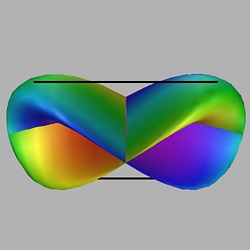

 |
A sphere immersed into four-dimensional space which intersects itself at exactly one point.
We immerse the 2-sphere into R4 by the equation
(x, y, x2 + xz, yz) where x2 + y2 + z2 = 1.
The main importance of this surface is that it is a simple example of a manifold that has a normal bundle with nontrivial characteristic classes, and it is good example of the connection between the geometry of a surface and its normal Euler number. Specifically, it is a closed surface in R4 that intersects itself at exactly one point (namely the north and south poles of the sphere are mapped to the origin in R4). In turn, this gives a simple example of a oriented surface with a nonzero normal Euler number (the integral of the normal curvature of the surface, also the obstruction to a global nonzero normal vector field). Specifically, the self-intersecting sphere has normal Euler number equal to 2.
The normal Euler number appears in various counting formulae for surfaces: the algebraic sum of zeros of a normal vector field (one definition of the normal Euler number), the algebraic number of pinch points of a projection of the surface into R3, the algebraic number of complex points [1, 2], and the author's bitangency formula [3]. This sphere is an important example for all these formulae, having not only a nonzero normal Euler number but also because its equation is simple enough to allow computation of other terms in the formulae.
The surface presented is a modification of a a more symmetric surface (x, y, xz, yz) found in [1], which in turn is a generalization of the figure eight curve (x, xy), x2+y2=1. Unfortunately, this surface has too much symmetry (all circles of latitude on the sphere map to circles on the surface), and so some generic conditions are lost. However, a modification in the quadratic terms will preserve the important geometric features of the surface while at the same time breaking up the symmetry, as well as allowing one to arbitrarily set the second-order local geometry at certain points on the surface.
The bitangency formula (a higher dimensional generalization of a formula for plane curves [4]) counts the algebraic number of bitangencies (pairs of points which share a common tangent line) and relates this number to the number of self intersections, the normal Euler number, and a "diagonal contribution" which comes from the local geometry of the surface [3]. When one projects the surface into R3 down the direction of a bitangency, the pair of points are mapped to a pair of overlapping pinch points. In our model, this can be seen in two places, marking two bitangencies on the surface. There are two other bitangencies on this surface, marked by the two lines on the picture above.
Model produced with: Geomview 1.6.1 with the Centerstage module
| Keywords | normal Euler number; complex point; bitangency | |
| MSC-2000 Classification | 53A07 (57R20) | |
| Zentralblatt No. | 05264882 |
Sphere-Cut.jvx contains the surface with alternate bands removed, useful for studying the cross sections.
Submitted: Mon Jun 18 19:06:54 MDT 2001.
Revised: Mon May 6 20:56:11 GMT 2002.
Accepted: Mon Sep 16 12:57:20 CEST 2002.
University of North Florida
Department of Mathematics and Statistics
4567 St. John's Bluff Rd.
Jacksonville, FL 32224
ddreibel@unf.edu
http://www.unf.edu/~ddreibel